.
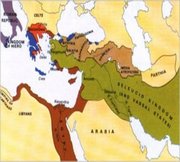
Seleucid empire in its greatest extent
After the death of Alexander the Great in the afternoon of 11 June 323 BC, his empire was divided by his generals, the so-called Diadochi. One of them was his friend Seleucus, who became king of the eastern provinces - more or less modern Afghanistan, Iran, Iraq, Syria, and Lebanon, together with parts of Turkey, Armenia, Turkmenistan, Uzbekistan, and Tajikistan. His kingdom had two capitals, which he founded in c.300: Antioch in Syria and Seleucia in Mesopotamia. Babylon was a third important city. The empire was, like the empire of Alexander, actually the continuation of the empires before: the Assyrian, Babylonian, and the Achaemenid Empire. The empite ended in 64 BC when the Romans made Syria a Roman province .
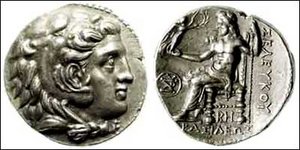
Seleucus I the Victorious 312-280 BC
The death of Alexander the Great (323 BC) saw the Macedonian army in a great confusion. The centralised Persian Empire was easy to govern once it was conquered, and the Macedonian military hegemony was by and large unthreatened, but the king had died without appointing a successor. Even a powerful heir would have found it hard to maintain Alexander's unifying authority, but as things were the kingship was divided between his feeble half-brother Philip III and his posthumous son Alexander IV. None of them were more than puppets in the hands of the Macedonian generals, the Diadochs, who soon sliced up the empire between them.
Their wars started soon after Ptolemy I seceded from the empire in the province of Egypt, but the complicated details of the fighting could not be accounted for here. Suffice to say that Persia proper was divided between various Macedonian satraps, who tried as best as they could to gain local support but relied mostly on their Greek mercenaries. In the outskirts of the empire, Persian satraps managed to claim independence during the wars; small kingdoms were established in Cappadocia and in the so-called Media Atropatene (today's Azerbaijan).
The satrap of Babylonia, the focal point between east and west, was called Seleucus and was a formidable administrator who soon formed a solid network of local supporters. After several wars with the leading Diadoch Antigonos the One-eyed, Seleucus crowned himself king in Babylonia in the year 306 BC. A few years after, all the satrapies to the east of Babylonia had yielded to him. In 301 BC, Antigonos was defeated by a coalition of other generals, and Seleucus became master of Syria as well, and in 281 BC he took Asia Minor and the wars of the Diadochs ended. At the age of eighty Seleukos was murdered by a fugitive Egyptian prince, but the throne passed on to Antiochus I (281-261 BC), his son by Persian noblewoman Apamea, and after that to his son Antiochus II (261-246 BC), who ruled as Great Kings from Samarkhand to the Aegean Sea.
System of Governing
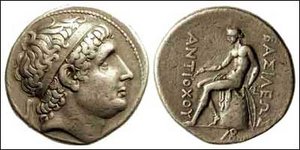
Antiochus I the Soter (280 to 261 BC)
The Seleucids built hundreds of cities and maintained or reformed the infrastructure of the Persian kings. The cities were based on the Greek polis-model with gymnasiums, amphitheatres and squares. Members of the indigenous upper classes often became hellenised, but the demotic languages were used in administration as well. The Greek influence was strictly limited to the cities and did not affect the countryside at all.
Though the army was based on Greek soldiers, a wide array of troops from Persia and Babylonia were incorporated, among them the cataphracts, the heavy cavalry of the Achaemenids. There were several nationalistic outbursts in Persis, but they were all suppressed, and the Seleucids strived for acceptance by acting as protectors for Persian and Babylonian cults. Ethnically the dynasty became partly Persian by marriages into the Persian kings of Cappadocia, who claimed ancestry from one of the seven followers of Darius I the Great.
Greek settlements in the empire were largely centered in Syria, the capital Antiochia being the most important, and to some extent Babylonia where the city Seleucia on Tigris succeeded Babylon as eastern city of residence. Paradoxically, many Greeks also lived in the outmost province of Bactria (Afghanistan/eastern Iran) many of them ethnic Greeks as opposed to ethnic Macedonians. Alexander had left his Greek infantry there, since he did not trust them, but historians also suggest that the Achaemenids used to deport rebellious Greek subjects there.
Unlike Alexandria in Egypt, the Seleucid Empire was no center of Hellenistic culture and science, but some of the Stoic philosophers came from Syria, and the world-leading physician Erasistratos lived at the court of Seleucus I. The Babylonian chronicles are the main source to the ancient Middle East history and was written by native Babylonian Berossos. The empire was the center of several important trade routes which gave the kings large revenues. Seleucid coins were a well renowned currency along the Silk route. Friendly relations were kept with the Mauryan kings of northern India, to whom Seleucus I had ceded eastern Pakistan in exchange for war elephants to use against his opponents in the west.
The first crisis and brief restoration
The mid-3rd century BC saw great turmoil in the Seleucid state after one of its many wars with Ptolemaic Egypt had gone terribly wrong. King Seleucus II, a son of Antiochus II, faced a civil war and during his reign the easternmost provinces broke free. These were the vast Bactria and Parthia, where nomads led by the Arsacid dynasty (from 247 BC) formed a small but warlike state on the verges of northern Iran. By and large though, most of Iran seems to have remained in the Seleucid fold even if the empire was continuously shaken by wars in all directions. Sadly the sources on the Seleucid empire focus on its western parts since most of the authors lived west of Syria. In the last years of the 3rd century BC the king Antiochus III, who was the last to claim the Persian title of Great King and therefore is called "the Great", brought the Seleucid army to the borders of India in a legendary campaign called the anabasis, during which the Parthian were defeated and Seleucid hegemony restored throughout the eastern dominions. He then defeated Egypt soundly and then invaded Greece to reclaim almost the entire part of Alexander's empire.
The Parthian conquest of Persia
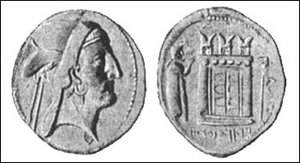
Bagadates coin, c. BC 222
Persis, the heartland of the Persian kings, had begun its route back to independence in the late 3rd century when the first indigenous Seleucid satraps were appointed. The earliest is supposed to be Bagadates, whose coin is shown here. The reverse depicts a king standing before a Zoroastrian sacred edifice or a fire-altar. With the weakening of the Seleucid Empire, the satraps became kings, some of which used names like Darius and Artaxerxes as tokens of their nationalistic spirit. Several other small kingdoms emerged as mushrooms in the temporary power vacuum.
It was however Parthia under its king Mithradates I that now rose as the main power in Persia, after having defeated the Medians and the Greeks of Bactria in the middle of the 2nd century BC. The latter disappeared soon afterwards, crushed by civil wars and the pressure of nomadic tribes who probably were allies of the Parthians. The other kingdoms of Iran were now turned into Parthian vassals.
Decline
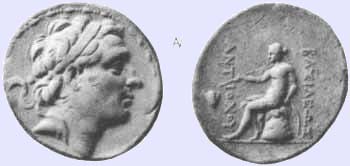
Silver coin of Antiochus III. The reverse shows Apollo seated on an omphalos. The Greek inscription reads ΒΑΣΙΛΕΩΣ ΑΝΤΙΟΧΟΥ (king Antiochus).
Antiochus III the Great, 223-187 BC
In 140 BC, the Seleucid king Demetrius II deciced that enough was enough and summoned whatever resources he had to check the Parthian advance. He was initially victorious and several vassals seceded from Mithradates II. The Parthians were however well-known for their defensive strength in their own country, and soon managed to ambush the Seleucid army and take Demetrious II captive. Babylonia now became a Parthian province.
The last round of the war came after the able Antiochus VII, the brother of Demetrius II, finally managed to win the civil wars in the remaining Seleucid dominions. He summoned a huge army of mercenaries and attacked the Parthians with great vigor. After three victories he had liberated Babylonia and western Iran and was already compared with Antiochus the Great.
The inhabitants had been happy to shake off the severe Parthian rule, but when the giant Seleucid army was divided put into winter quarters this turned out to be just as bad for the hosting cities. Parthian spies were able to stir up rebellions against the Seleucids, and when Antiochus VII tried to assemble his troops he was routed and killed by the Parthian king Phraates II in a battle outside Hamadan. The rest of the leaderless army was shattered or put into the Parthian ranks. This was the definite end of the Hellenistic period in Iran.
The last remaining Seleucid kings only controlled ever-decreasing parts of Syria. Their last half-century was plagued by unending civil wars, until the Romans made Syria a Roman province in 64 BC. The Greek influence in the east survived its rulers for a while, even though few of the Hellenistic cities were found east of Babylonia. The Parthian rulers continued throughout their reign to strike coins in Greek, and several of them gave themselves the epithet Philhellenos (friend of the Greeks). This was probably to ensure support from the Greek societies, which were still important (and heavily fortified) centers of commerce. But eventually Greek impact faded. The Roman campaigns in Parthia in the 2nd century AD seems to have swept away the last of the Greek colonists.
It is as mentioned odd to note that Bactria, the hinterland on the eastern Iranian plateau, despite its distance to Greece boasted a numerous and prospering Greek colony. The Greeks here also seemed to have been better integrated and even managed to expand beyond the former Achaemenid frontiers beyond Punjab and Kashmir, as well as becoming masters of today's Pakistan in the early 2nd century BC. Even though the empire soon collapsed, the Greeks left a pronounced cultural heritage, the so-called Gandhara culture.
The dream of reuniting Alexander's empire was long alive among the Hellenistic kings, and the references to him were legion in Hellenistic kingship. At the donations of Alexandria in 34 BC, queen Cleopatra and the Roman general Marcus Antonius even went so far as to crown their son Alexander Helios (the Sun) to Great King of Parthia and Media. This was however but an arrogant empty gesture, since these countries were by that time far beyond the grasp of Greeks as well as Romans.
Seleucid rulers
Seleucus I Nicator (Satrap 311-–305 BC, King 305 BC–281 BC) was one of Alexander the Great's generals who, after Alexander's death in 323 BC, founded the Seleucid Empire. He established himself and his family in Mesopotamia and the Iranian plateau, ruling as far as the Indus region. He founded Seleucia on the Tigris River (around 305) as a new royal capital.
- Antiochus I Soter (co-ruler from 291, ruled 281–-261 BC)
- Antiochus II Theos (261–-246 BC)
- Seleucus II Callinicus ( 246–-225 BC)
- Seleucus III Ceraunus (or Soter) ( 225-–223 BC)
- Antiochus III the Great (223-–187 BC)
- Seleucus IV Philopator (187–-175 BC)
- Antiochus IV Epiphanes (175–-164 BC)
- Antiochus V Eupator (164-–162 BC)
- Demetrius I Soter (161-–150 BC)
- Alexander I Balas (154-–145 BC)
- Demetrius II Nicator (first reign, 145-–138 BC)
- Antiochus VI Dionysus (or Epiphanes) (145–-140 BC?)
- Diodotus Tryphon (140?-138 BC)
- Antiochus VII Sidetes (or Euergetes) ( 138–-129 BC)
- Demetrius II Nicator (second reign, 129-–126 BC)
- Alexander II Zabinas (129–-123 BC)
- Cleopatra Thea (126–-123 BC)
- Seleucus V Philometor (126/125 BC)
- Antiochus VIII Grypus (125-–96 BC)
- Antiochus IX Cyzicenus (114–-96 BC)
- Seleucus VI Epiphanes Nicator (96-–95 BC)
- Antiochus X Eusebes Philopator (95-–92 BC or 83 BC)
- Demetrius III Eucaerus (or Philopator) (95-–87 BC)
- Antiochus XI Epiphanes Philadelphus (95–-92 BC)
- Philip I Philadelphus (95–-84/83 BC)
- Antiochus XII Dionysus (87-–84 BC)
- (Tigranes I of Armenia) (83-–69 BC)
- Antiochus XIII Asiaticus (69–-64 BC)
- Philip II Philoromaeus (65-–63 BC)
- Seleucus VII Kybiosaktes or Philometor (70s BC-60s BC?)

Retrieved from "http://en.wikipedia.org/wiki/Seleucid_dynasty", based on an article written by Jens Jakobsson (jens.jakobsson@spray.se)
| Ancient Greece
Science, Technology , Medicine , Warfare, , Biographies , Life , Cities/Places/Maps , Arts , Literature , Philosophy ,Olympics, Mythology , History , Images Medieval Greece / Byzantine Empire Science, Technology, Arts, , Warfare , Literature, Biographies, Icons, History Modern Greece Cities, Islands, Regions, Fauna/Flora ,Biographies , History , Warfare, Science/Technology, Literature, Music , Arts , Film/Actors , Sport , Fashion --- |
Retrieved from "http://en.wikipedia.org/"
All text is available under the terms of the GNU Free Documentation License

